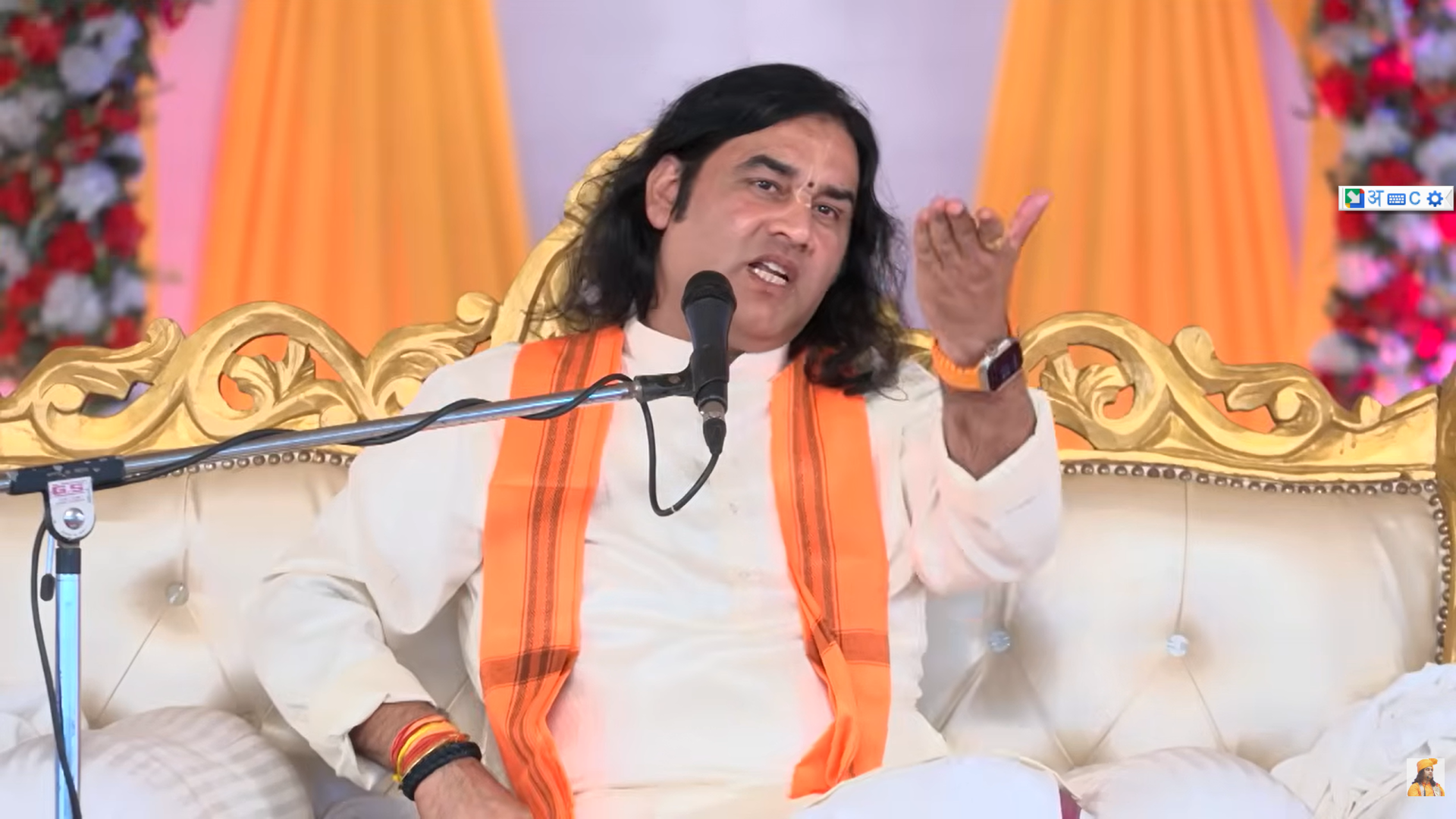
#Mind #Thoughts #PremanandMaharaj #Spirituality #NaamJapa #BhajanMarg #InnerPeace #DualityOfMind #Satsang #Vrindavan
Hindi-English Combined Short Heading
मन के विचारों की विविधता: Insights by Premanand Maharaj | Diversity of Thoughts in Mind
हिंदी लेख: मन में अलग-अलग विचार क्यों आते हैं?
प्रस्तावना
मनुष्य का मन अत्यंत जटिल और रहस्यमय है। मन में निरंतर विचारों का प्रवाह चलता रहता है—कभी अच्छे, कभी बुरे, कभी सकारात्मक, कभी नकारात्मक। यह प्रश्न हर साधक के मन में आता है कि आखिर मन में इतने भिन्न-भिन्न विचार क्यों आते हैं? इस विषय पर परम पूज्य वृंदावन रसिक संत श्री हित प्रेमानंद गोविंद शरण जी महाराज ने अपने प्रवचन में अत्यंत सरल, गूढ़ और व्यावहारिक ढंग से प्रकाश डाला है। प्रस्तुत लेख में उन्हीं की वाणी और शिक्षाओं के आधार पर इस प्रश्न का विस्तार से उत्तर दिया गया है।
मन, बुद्धि और चेतना का तालमेल
महाराज जी कहते हैं कि साधना में मन, बुद्धि और चेतना का तालमेल अत्यंत आवश्यक है। जब तक मन पवित्र नहीं होता, वह साधक का साथ नहीं देता। मन के दो भाग होते हैं—एक सत (शुद्ध) और एक असत (अशुद्ध)। जब हम कोई गलत कार्य करते हैं, तो प्रेरणा देने वाला भी मन ही होता है और पश्चाताप करने वाला भी मन ही होता है। यही मन के दो स्वरूप हैं।
बुद्धि के भी दो स्वरूप होते हैं—कुमति (दुष्ट बुद्धि) और सुमति (शुद्ध बुद्धि)। सुंदर निर्णय करने वाली बुद्धि सुमति कहलाती है, जबकि गंदा निर्णय करने वाली कुमति। यदि किसी की सुमति बलवान है, तो वह कुमार्गगामी प्रवृत्तियों को रोककर अच्छे मार्ग पर ले जाती है। इसी प्रकार, मन के भी दो विभाग हैं—सत मन और असत मन।
सत मन और असत मन की भूमिका
महाराज जी स्पष्ट करते हैं कि असत मन हमें गलत कार्यों की ओर प्रेरित करता है, जबकि सत मन पश्चाताप करता है और सही मार्ग पर चलने की प्रेरणा देता है। उदाहरण के लिए, जब कोई साधक माला जपता है और कुछ माला छूट जाती है, तो उसे बुरा लगता है। यह सत मन की अभिव्यक्ति है। लेकिन जब वही मन माला जपते समय गलत चिंतन करता है, तो वह असत मन का प्रभाव है।
मन की शुद्धि का मार्ग
महाराज जी के अनुसार, असत मन को सत विभाग में बदलना ही साधना का मुख्य उद्देश्य है। जैसे-जैसे साधक नाम जप करता है, गंदे विचार और संस्कार मन से निकलते जाते हैं। सत विभाग बढ़ता है और असत विभाग कमजोर होता जाता है। जब पूरा मन सत हो जाता है, तब भगवत प्राप्ति संभव होती है। “निर्मल मन जन सो मोहि पावा”—निर्मल मन ही भगवान को प्राप्त कर सकता है।
विचारों का प्रवाह और संस्कार
महाराज जी मन की तुलना एक चिप या मेमोरी कार्ड से करते हैं, जिसमें अनंत जन्मों के संस्कार भरे हुए हैं। जब साधक नाम जप करता है, तो ये पुराने संस्कार और गंदे विचार बाहर निकलने लगते हैं। यह प्रक्रिया धीरे-धीरे होती है। साधक को धैर्य रखना चाहिए और नाम जप बढ़ाते रहना चाहिए। जैसे-जैसे नाम जप बढ़ता है, वैसे-वैसे गंदे विचार निकलते जाते हैं और मन शुद्ध होता जाता है।
साधना में धैर्य और निरंतरता
महाराज जी कहते हैं कि साधना में धैर्य और निरंतरता अत्यंत आवश्यक है। यदि साधक को लगता है कि उसे साधना का कोई लाभ नहीं मिल रहा, तो इसका कारण यह है कि अभी प्रारब्ध भोग चल रहा है। जैसे-जैसे प्रारब्ध समाप्त होगा, साधना का फल स्वतः अनुभव में आएगा। साधक को चाहिए कि वह बिना घबराए, निरंतर नाम जप करता रहे।
मन की व्यथा और सहनशीलता
भगवान श्रीकृष्ण के वचन का उल्लेख करते हुए महाराज जी कहते हैं कि जो साधक मन की व्यथा, जलन और अशांति को सहन कर लेता है, वही सुख-दुख को समान समझने वाला अमृत पद का अधिकारी बनता है। मन में जो अशांति, जलन या गंदे विचार आते हैं, उन्हें सहना और उनसे विचलित न होना ही साधना की सफलता का मार्ग है।
गलत आचरण से बचाव
महाराज जी चेतावनी देते हैं कि यदि साधक गलत आचरण करता है, तो असत विभाग और बलवान हो जाता है और सत विभाग कमजोर पड़ जाता है। इसलिए साधक को चाहिए कि वह गलत आचरण से बचे और मन में आने वाली व्यथा को सहन करे। यदि साधक चूक नहीं करता, तो धीरे-धीरे वह ऊँचाई की ओर बढ़ता है और एक दिन उसका मन शांत हो जाता है।
नाम जप की महिमा
महाराज जी बार-बार नाम जप की महिमा का उल्लेख करते हैं। उनका कहना है कि नाम जप के द्वारा ही मन के गंदे संस्कार और विचार बाहर निकलते हैं। यह प्रक्रिया धीरे-धीरे होती है, लेकिन निरंतरता और धैर्य से साधक का मन शुद्ध होता जाता है। जब मन पूरी तरह निर्मल हो जाता है, तब साधक भगवत स्वरूप में स्थित हो जाता है।
मन के विचार क्यों आते हैं—मूल कारण
महाराज जी के अनुसार, मन में अलग-अलग विचार आने का मुख्य कारण हमारे अनंत जन्मों के संस्कार हैं, जो मन रूपी चिप में भरे हुए हैं। जब साधक नाम जप करता है, तो ये संस्कार बाहर निकलते हैं। साधक को यह समझना चाहिए कि ये विचार आ नहीं रहे, बल्कि निकल रहे हैं। नाम जप के द्वारा मन की सफाई हो रही है।
साधक के लिए संदेश
महाराज जी साधकों को संदेश देते हैं कि वे धैर्यपूर्वक नाम जप करते रहें, मन में आने वाले विचारों से घबराएँ नहीं। जैसे-जैसे नाम जप बढ़ेगा, वैसे-वैसे मन शुद्ध होता जाएगा और अंततः निर्मल मन की प्राप्ति होगी, जो भगवत प्राप्ति का मार्ग है।
निष्कर्ष
मन में अलग-अलग विचार आना स्वाभाविक है, क्योंकि यह हमारे पुराने संस्कारों का परिणाम है। साधना, विशेषकर नाम जप, के द्वारा इन विचारों और संस्कारों की शुद्धि संभव है। धैर्य, निरंतरता और सही आचरण के साथ साधक अपने मन को निर्मल बना सकता है और भगवत प्राप्ति के मार्ग पर अग्रसर हो सकता है। महाराज जी की शिक्षाएँ साधकों के लिए अमूल्य मार्गदर्शन हैं, जो मन की जटिलताओं को सरलता से समझाती हैं और साधना के पथ पर दृढ़ता प्रदान करती हैं।
English Article: Why Do Different Thoughts Arise in the Mind?
Introduction
The human mind is a complex and mysterious entity. Thoughts constantly flow through it—sometimes good, sometimes bad, sometimes positive, sometimes negative. Every spiritual aspirant wonders: why do so many different thoughts arise in the mind? Param Pujya Vrindavan Rasik Sant Shri Hit Premanand Govind Sharan Ji Maharaj, in his profound discourse, has shed light on this question in a simple, deep, and practical manner. This article is based entirely on his teachings and words, providing a comprehensive answer to this age-old question.
Harmony of Mind, Intellect, and Consciousness
Maharaj Ji emphasizes that harmony between the mind, intellect, and consciousness is essential in spiritual practice. Until the mind is purified, it does not support the practitioner. The mind has two parts—one pure (sat) and one impure (asat). When we commit a wrong act, the inspiration to do so comes from the mind, and the subsequent repentance also arises from the mind. These are the two forms of the mind.
Similarly, the intellect has two forms—kumati (evil intellect) and sumati (pure intellect). The intellect that makes beautiful decisions is sumati, while the one that makes bad decisions is kumati. If someone’s sumati is strong, it restrains negative tendencies and leads to the right path. In the same way, the mind has two departments—sat mind and asat mind.
The Role of Sat Mind and Asat Mind
Maharaj Ji explains that the asat mind inspires us towards wrong actions, while the sat mind repents and motivates us to walk the right path. For example, when a practitioner chants mala (rosary) and misses a few rounds, he feels bad. This is the expression of the sat mind. But when the same mind indulges in wrong thoughts during chanting, it is the influence of the asat mind.
The Path of Purification of the Mind
According to Maharaj Ji, the main objective of spiritual practice is to transform the asat mind into the sat department. As the practitioner continues naam japa (chanting the divine name), dirty thoughts and impressions are expelled from the mind. The sat department grows stronger, and the asat department weakens. When the entire mind becomes sat, divine realization becomes possible. “Nirmal man jan so mohi pava”—only a pure mind can attain God.
The Flow of Thoughts and Impressions
Maharaj Ji compares the mind to a chip or memory card, filled with impressions from countless lifetimes. When the practitioner does naam japa, these old impressions and dirty thoughts begin to surface. This process is gradual. The practitioner must be patient and continue increasing naam japa. As naam japa increases, dirty thoughts are expelled, and the mind becomes purer.
Patience and Consistency in Practice
Maharaj Ji says that patience and consistency are essential in spiritual practice. If a practitioner feels that he is not getting any benefit from his practice, it is because his prarabdha (destined karma) is still being experienced. As prarabdha is exhausted, the fruits of practice will be experienced automatically. The practitioner should continue naam japa without fear or doubt.
Enduring the Mind’s Distress
Quoting Lord Krishna, Maharaj Ji says that the practitioner who endures the mind’s distress, burning, and restlessness becomes eligible for the nectar-like state of equanimity. The unrest, burning, or dirty thoughts that arise in the mind must be endured and not acted upon. This endurance is the path to success in spiritual practice.
Avoiding Wrong Conduct
Maharaj Ji warns that if the practitioner indulges in wrong conduct, the asat department becomes stronger, and the sat department weakens. Therefore, the practitioner should avoid wrong actions and endure the distress that arises in the mind. If the practitioner does not make mistakes, he gradually ascends to higher states, and one day, his mind becomes peaceful.
The Glory of Naam Japa
Maharaj Ji repeatedly emphasizes the glory of naam japa. He says that only through naam japa can the dirty impressions and thoughts in the mind be expelled. This process is gradual, but with consistency and patience, the practitioner’s mind becomes purer. When the mind is completely pure, the practitioner becomes established in the divine form.
The Root Cause of Thoughts in the Mind
According to Maharaj Ji, the main reason for different thoughts arising in the mind is the impressions from countless past lives, stored in the mind like a chip. When the practitioner does naam japa, these impressions are expelled. The practitioner should understand that these thoughts are not coming in, but are being expelled. Naam japa is cleansing the mind.
Message for Practitioners
Maharaj Ji advises practitioners to continue naam japa patiently and not be afraid of the thoughts that arise in the mind. As naam japa increases, the mind becomes purer, and ultimately, the practitioner attains a pure mind, which is the path to divine realization.
Conclusion
It is natural for different thoughts to arise in the mind, as they are the result of our old impressions. Through spiritual practice, especially naam japa, these thoughts and impressions can be purified. With patience, consistency, and right conduct, the practitioner can purify his mind and progress on the path to divine realization. Maharaj Ji’s teachings are invaluable guidance for practitioners, simplifying the complexities of the mind and providing steadfastness on the path of spiritual practice.
End of Article







